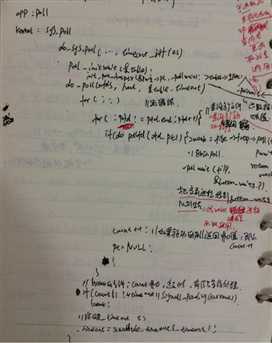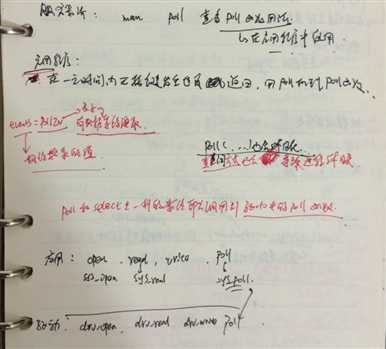标签:
使用非阻塞I/O的应用程序通常会使用select()和poll()系统调用查询是否可对设备进行无阻塞的访问,这两个系统调用最终又会引发设备驱动中的poll()函数被执行
如果当前不可读(先调用驱动.poll确定是否可读,然后继续do_poll),那么在sys_poll->do_poll中当前进程就会睡眠在等待队列上,这个等待队列是由驱动程序提供的(就是poll_wait中传入的那个)。当可读的时候,驱动程序可能有一部分代码运行了(比如驱动的中断服务
程序),那么在这部分代码中,就会唤醒等待队列上的进程,也就是之前睡眠的那个,当那个进程被唤醒后do_poll会再一次的调用驱动程序的poll函数,这个时候应用程序就知道是可读的了。
首先,先说说Poll函数的使用,原理部分见文章最后的附图,我们直接看程序代码示例比较直观:
1.应用程序:
#include <fcntl.h>
#include <stdio.h>
#include <poll.h>
/* forthdrvtest
*/
int main(int argc, char **argv)
{
int fd;
unsigned char key_val;
int ret;
struct pollfd fds[1];
fd = open("/dev/buttons", O_RDWR);
if (fd < 0)
{
printf("can‘t open!\n");
}
fds[0].fd = fd;
fds[0].events = POLLIN;//期待获取的值是有数据等待读取
while (1)
{
ret = poll(fds, 1, 5000);//查询一个文件fds
if (ret == 0)
{
printf("time out\n");
}
else
{
read(fd, &key_val, 1);
printf("key_val = 0x%x\n", key_val);
}
}
return 0;
2.驱动程序:
#include <linux/module.h>
#include <linux/kernel.h>
#include <linux/fs.h>
#include <linux/init.h>
#include <linux/delay.h>
#include <linux/irq.h>
#include <asm/uaccess.h>
#include <asm/irq.h>
#include <asm/io.h>
#include <asm/arch/regs-gpio.h>
#include <asm/hardware.h>
#include <linux/poll.h>
static struct class *forthdrv_class;
static struct class_device *forthdrv_class_dev;
volatile unsigned long *gpfcon;
volatile unsigned long *gpfdat;
volatile unsigned long *gpgcon;
volatile unsigned long *gpgdat;
static DECLARE_WAIT_QUEUE_HEAD(button_waitq);
/* 中断事件标志, 中断服务程序将它置1,forth_drv_read将它清0 */
static volatile int ev_press = 0;
struct pin_desc{
unsigned int pin;
unsigned int key_val;
};
/* 键值: 按下时, 0x01, 0x02, 0x03, 0x04 */
/* 键值: 松开时, 0x81, 0x82, 0x83, 0x84 */
static unsigned char key_val;
struct pin_desc pins_desc[4] = {
{S3C2410_GPF0, 0x01},
{S3C2410_GPF2, 0x02},
{S3C2410_GPG3, 0x03},
{S3C2410_GPG11, 0x04},
};
/*
* 确定按键值
*/
static irqreturn_t buttons_irq(int irq, void *dev_id)
{
struct pin_desc * pindesc = (struct pin_desc *)dev_id;
unsigned int pinval;
pinval = s3c2410_gpio_getpin(pindesc->pin);
if (pinval)
{
/* 松开 */
key_val = 0x80 | pindesc->key_val;
}
else
{
/* 按下 */
key_val = pindesc->key_val;
}
ev_press = 1; /* 表示中断发生了 */
wake_up_interruptible(&button_waitq); /* 唤醒休眠的进程 */
return IRQ_RETVAL(IRQ_HANDLED);
}
static int forth_drv_open(struct inode *inode, struct file *file)
{
/* 配置GPF0,2为输入引脚 */
/* 配置GPG3,11为输入引脚 */
request_irq(IRQ_EINT0, buttons_irq, IRQT_BOTHEDGE, "S2", &pins_desc[0]);
request_irq(IRQ_EINT2, buttons_irq, IRQT_BOTHEDGE, "S3", &pins_desc[1]);
request_irq(IRQ_EINT11, buttons_irq, IRQT_BOTHEDGE, "S4", &pins_desc[2]);
request_irq(IRQ_EINT19, buttons_irq, IRQT_BOTHEDGE, "S5", &pins_desc[3]);
return 0;
}
ssize_t forth_drv_read(struct file *file, char __user *buf, size_t size, loff_t *ppos)
{
if (size != 1)
return -EINVAL;
/* 如果没有按键动作, 休眠 */
wait_event_interruptible(button_waitq, ev_press);
/* 如果有按键动作, 返回键值 */
copy_to_user(buf, &key_val, 1);
ev_press = 0;
return 1;
}
int forth_drv_close(struct inode *inode, struct file *file)
{
free_irq(IRQ_EINT0, &pins_desc[0]);
free_irq(IRQ_EINT2, &pins_desc[1]);
free_irq(IRQ_EINT11, &pins_desc[2]);
free_irq(IRQ_EINT19, &pins_desc[3]);
return 0;
}
static unsigned forth_drv_poll(struct file *file, poll_table *wait)
{
unsigned int mask = 0;
poll_wait(file, &button_waitq, wait); // 不会立即休眠
if (ev_press)
mask |= POLLIN | POLLRDNORM;//自己查找分析?
return mask;
}
static struct file_operations sencod_drv_fops = {
.owner = THIS_MODULE, /* 这是一个宏,推向编译模块时自动创建的__this_module变量 */
.open = forth_drv_open,
.read = forth_drv_read,
.release = forth_drv_close,
.poll = forth_drv_poll,
};
int major;
static int forth_drv_init(void)
{
major = register_chrdev(0, "forth_drv", &sencod_drv_fops);
forthdrv_class = class_create(THIS_MODULE, "forth_drv");
forthdrv_class_dev = class_device_create(forthdrv_class, NULL, MKDEV(major, 0), NULL, "buttons"); /* /dev/buttons */
gpfcon = (volatile unsigned long *)ioremap(0x56000050, 16);
gpfdat = gpfcon + 1;
gpgcon = (volatile unsigned long *)ioremap(0x56000060, 16);
gpgdat = gpgcon + 1;
return 0;
}
static void forth_drv_exit(void)
{
unregister_chrdev(major, "forth_drv");
class_device_unregister(forthdrv_class_dev);
class_destroy(forthdrv_class);
iounmap(gpfcon);
iounmap(gpgcon);
return 0;
}
module_init(forth_drv_init);
module_exit(forth_drv_exit);
MODULE_LICENSE("GPL");
其次,我们看一下实际使用的比较多的Select函数:
select()函数、
同样select中,Poll方法只是做一个登记,真正的阻塞发生在select.c 中的 do_select函数。
原型如下:
int select(int fdsp1, fd_set *readfds, fd_set *writefds, fd_set *errorfds, const struct timeval *timeout);
各个参数含义如下:
int fdsp1:最大描述符值 + 1
fd_set *readfds:对可读感兴趣的描述符集
fd_set *writefds:对可写感兴趣的描述符集
fd_set *errorfds:对出错感兴趣的描述符集
struct timeval *timeout:超时时间
select函数会在发生以下情况时返回:
1 readfds集合中有描述符可读
2 writefds集合中有描述符可写
3 errorfds集合中有描述符遇到错误条件
4 指定的超时时间timeout到了
3、Select系统调用(返回值)
Select调用返回时,返回值有如下情况:
1)正常情况下返回满足要求的文件描述符个数;
2)经过了timeout等待后仍无文件满足要求,返回值为0;
3)如果select被某个信号中断,它将返回-1并设置errno为EINTR。
4)如果出错,返回-1并设置相应的errno。
4、Select系统调用(使用方法)
1)将要监控的文件添加到文件描述符集
2)调用Select开始监控
3)判断文件是否发生变化
系统提供了4个宏对描述符集进行操作:
#include <sys/select.h>
void FD_SET(int fd, fd_set *fdset)
void FD_CLR(int fd, fd_set *fdset)
void FD_ZERO(fd_set *fdset)
void FD_ISSET(int fd, fd_set *fdset)
宏FD_SET将文件描述符fd添加到文件描述符集fdset中;
宏FD_CLR从文件描述符集fdset中清除文件描述符fd;
宏FD_ZERO清空文件描述符集fdset;
在调用select后使用FD_ISSET来检测文件描述符集fdset中的文件fd发生了变化。
FD_ZERO(&fds); //清空集合
FD_SET(fd1,&fds); //设置描述符
FD_SET(fd2,&fds); //设置描述符
maxfdp=fd1+1; //描述符最大值加1,假设fd1>fd2
switch(select(maxfdp,&fds,NULL,NULL,&timeout))
case -1: exit(-1);break; //select错误,退出程序
case 0:break;
default:
if(FD_ISSET(fd1,&fds)) //测试fd1是否可读
unsigned int (*poll)(struct file *filp, struct poll_table *wait);
这个函数要进行下面两项工作。首先,对可能引起设备文件状态变化的等待队列调用poll_wait(),将对应的等待队列头添加到poll_table.
然后,返回表示是否能对设备进行无阻塞读写访问的掩码。在上面提到了一个poll_wait()函数,它的原型:
void poll_wait(struct file *filp, wait_queue_head_t *queue, poll_table *wait);
它的作用就是把当前进程添加到wait参数指定的等待列表(poll_table)中。需要注意的是这个函数是不会引起阻塞的,呵呵,谁给它取得个
名字带wait的,给咱们添这么多麻烦。
static unsigned int mem_poll(struct file *filp,poll_table *wait)
{
struct scull_pipe *dev =filp->private_data;
unsigned int mask =0;
/* 把等待队列添加到poll_table */
poll_wait(filp,&dev->inq,wait);
/*返回掩码*/
if (有数据可读)
mask = POLLIN |POLLRDNORM;/*设备可读*/
return mask;
}
例:
int main()
{
int fd;
fd_set rds; //声明描述符集合
int ret;
char Buf[128];
/*初始化Buf*/
strcpy(Buf,"memdev is char dev!");
printf("BUF: %s\n",Buf);
/*打开设备文件*/
fd = open("/dev/memdev0",O_RDWR);
FD_ZERO(&rds); //清空描述符集合
FD_SET(fd, &rds); //设置描述符集合
/*清除Buf*/
strcpy(Buf,"Buf is NULL!");
printf("Read BUF1: %s\n",Buf);
ret = select(fd + 1, &rds, NULL, NULL, NULL);//调用select()监控函数
if (ret < 0)
{
printf("select error!\n");
exit(1);
}
if (FD_ISSET(fd, &rds)) //测试fd1是否可读
read(fd, Buf, sizeof(Buf));
/*检测结果*/
printf("Read BUF2: %s\n",Buf);
close(fd);
return 0;
}
1.select的第一个参数nfds为fdset集合中最大描述符值加1,fdset是一个位数组,其大小限制为__FD_SETSIZE(1024),位数组的每一位
代表其对应的描述符是否需要被检查。
select的第二三四个参数表示需要关注读、写、错误事件的文件描述符位数组,这些参数既是输入参数也是输出参数,可能会被内核修改用
于标示哪些描述符上发生了关注的事件。所以每次调用select前都需要重新初始化fdset。
timeout参数为超时时间,该结构会被内核修改,其值为超时剩余的时间。
select对应于内核中的sys_select调用,sys_select首先将第二三四个参数指向的fd_set拷贝到内核,然后对每个被SET的描述符调用进行
poll,并记录在临时结果中(fdset),如果有事件发生,select会将临时结果写到用户空间并返回;当轮询一遍后没有任何事件发生时,
如果指定了超时时间,则select会睡眠到超时,睡眠结束后再进行一次轮询,并将临时结果写到用户空间,然后返回。
select返回后,需要逐一检查关注的描述符是否被SET(事件是否发生)。
Select原理:
select系统调用的代码在fs/Select.c下,
前面是从用户控件拷贝各个fd_set到内核空间,接下来的具体工作在core_sys_select中,
core_sys_select->do_select,真正的核心内容在do_select里:
mask = (*f_op->poll)(file, retval ? NULL : wait);
这个是调用文件系统的 poll函数,不同的文件系统poll函数自然不同,由于我们这里关注的是tcp连接,而
socketfs的注册在 net/Socket.c里。register_filesystem(&sock_fs_type); socket文件系统的函数也是在
net/Socket.c里:
从sock_poll跟随下去,
最后可以到 net/ipv4/tcp.c的
unsigned int tcp_poll(struct file *file, struct socket *sock, poll_table *wait)
这个是最终的查询函数,
也就是说select 的核心功能是调用tcp文件系统的poll函数,不停的查询,如果没有想要的数据,主动执行一次调度(防止一直占用cpu)
,直到有一个连接有想要的消息为止。
从这里可以看出select的执行方式基本就是不同的调用poll,直到有需要的消息为止,如果select 处理的socket很多,这其实对整个机器的性能也是一个消耗。
很简单吧,最后附笔者的笔记:
Poll原理:


标签:
原文地址:http://www.cnblogs.com/yuweifeng/p/5598087.html